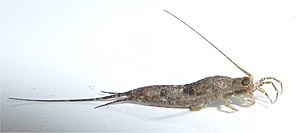Rock diver
| Rock diver | ||||||||||
|---|---|---|---|---|---|---|---|---|---|---|

Rock diver |
||||||||||
| Systematics | ||||||||||
|
||||||||||
| Scientific name | ||||||||||
| Archaeognatha | ||||||||||
| Borner , 1904 |
The rock jumpers (Archaeognatha) are an order of the insects (Insecta). Of the 450 known species of the group, 15 are also distributed in Central Europe, all of which are assigned to the Machilidae .
features
Most species are 9 to 18 mm long, the Machilis ingens species reaches a total length of about 23 mm.
The body of the rock jumpers is covered with mostly shiny scales , the large compound eyes that meet in the middle on the head are striking . The antennas are very long and can have up to 250 individual links. Also striking are the long, as mouthparts serving Labialtaster .
The second to ninth segments of the abdomen ( abdomen ) each have a pair of movable limb remnants ( stylus ) and flat coxopodites . The first seven abdominal segments also have so-called coxal vesicles , which are paired and can be turned out. On the abdomen, the animals have three long and multi-limbed tail appendages , consisting of the paired cerci and the unpaired terminal filum .
Way of life
The species of rock jumpers are mainly found in damp and stony areas, for example in the splash zone of the sea or on rocky slopes, on moss cushions and under tree bark. They feed on algae , lichens and organic matter. They get their name from their considerable jumping ability, where they push themselves off the ground with the help of their tail appendages (terminal filum and cerci ) and their legs.
Systematics
The order of the rock jumpers is divided into two superfamilies: The Triassomachiloidea Sturm & Bach (1993), with only one known fossil species, Triassomachilis uralensis , and the Machiloidea Handlirsch (1903), with the two recent families Machilidae and Meinertellidae .
The animals represent the most original group of real insects (according to other literature also the Ectognatha (Freikiefler)). Unlike all the following groups, they have a one-piece mandible joint, while in the higher taxa a second joint has developed and thus forms a dicondyle mandible . Accordingly, the rock jumpers are referred to as Archaeognatha ("old jaw animals") and the following groups as Dicondylia . Their closest relatives outside of the flying insects (Pterygota) are probably the fish i. w. S. (Zygentoma).
Among the fossil evidence, the species Machilis diastatica , which occurs in the Eocene Baltic amber, is noteworthy, as it is practically indistinguishable from the modern Machilis polypoda . This means that at least this species, but probably also other members of the Machilidae family, has existed almost unchanged for around 50 million years.
literature
- Bernhard Klausnitzer : Archaeognatha, rock diver. In: Wilfried Westheide , Reinhard Rieger (Ed.): Special Zoology. Part 1: Protozoa and invertebrates. Gustav Fischer, Stuttgart et al. 1996, ISBN 3-437-20515-3 , pp. 626-627.
- Helmut Sturm , Ryuichiro Machida (Ed.): Archaeognatha (= Handbook of Zoology. Volume 4: Arthropoda: Insecta. Part 37). de Gruyter, Berlin et al. 2001, ISBN 3-11-017058-2 .
Individual evidence
- ↑ Helmut Sturm, Ryuichiro Machida (ed.): Archaeognatha. 2001, p. 17.
- ↑ Filippo Silvestri: The Thysanura of the Baltic amber. In: Writings of the Physikalisch-Ökonomische Gesellschaft zu Königsberg in Prussia. 53, 1912, ZDB -ID 203341-0 , pp. 42-66; quoted in: Sven Gisle Larsson: Baltic amber. A Palaebiological Study (= Entomonograph. Vol. 1). Scandinavian Science Press, Klampenborg (Denmark) 1978, ISBN 87-87491-16-8 .
